This concept was introduced by R.G. Pearson in 1963. He classified acids and bases based on their polarizability, creating the idea of "soft" and "hard" acids and bases (SHAB).
1. Hard Acid:
A hard acid is characterized by:
- Small size
- High positive charge
- No easily excited valence electrons
- Low polarizability
- Lighter in weight
- Fewer valence electrons
- High oxidation state
Examples: Li+1, Ca+2, Al+3, H+, Be+2, Mg+2
2. Soft Acid:
A soft acid is characterized by:
- Large size
- Greater number of valence electrons
- Heavier atoms
- High polarizability
- Low oxidation state
- Zero or low positive charge
- Several valence electrons that can be easily excited
Examples: Ag+1, Hg+2, Cu+2, Au+
3. Hard Base:
A hard base is characterized by:
- Low polarizability
- High electronegativity
- Resistance to oxidation
- Association with empty orbitals of high energy
Examples: F-1, Cl-1, OH-1
4. Soft Base:
A soft base is characterized by:
- High polarizability
- Low electronegativity
- Ease of oxidation
- Association with low-energy orbitals
Examples: P, S-2, CN-1, I-1
🔗 Other Useful Links
- News By Amurchem
- Free Web Development Course
- All-in-One Exam Prep Portal
- Articles by Amurchem
- Grade 12 Section
- Grade 11 Section
- Grade 10 Section
- Grade 09 Section
- Home and Online Tuition
- Labs By Amurchem
- Science Lectures By Amurchem
© 2025 AmurChem. All rights reserved.
Tags
Chemistry Grade 11
Federal Board
Hard Acids
Hard Bases
Pearson Acid-Base Theory
PTB Chemistry
SHAB Concept
Soft Acids
Soft and Hard Acid Base
Soft Bases






